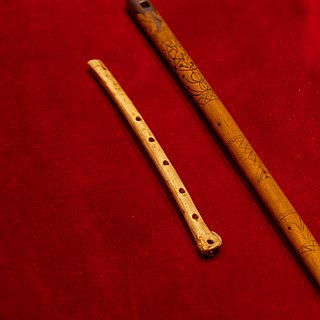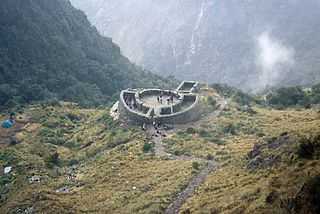Cusco–Collao or Qusqu–Qullaw (Quechua) is a collective term used for Quechua dialects that have aspirated and ejective plosives, apparently borrowed from Aymaran languages. They include Cusco Quechua, Puno Quechua, North Bolivian Quechua, and South Bolivian Quechua. Together with Ayacucho Quechua, which is mutually intelligible, they form the Southern Quechua language.

A pinkillu, pinkuyllu or pinqullu is a flute found throughout the Andes, used primarily in Argentina northwest, Bolivia, Chile, Ecuador and Peru. It is usually played with one hand, leaving the other one free to accompany oneself on a drum like the tinya. It is used in a variety of public festivals and other kinds of communal ceremonies.

Utcubamba or Utkhupampa is a river in the Amazonas Region of Peru, located at 5°32′6″S78°33′9″W. The name is a historical reference to the past agricultural practice of growing cotton in the Utcubamba Valley.

Southern Quechua, or simply Quechua, is the most widely spoken of the major regional groupings of mutually intelligible dialects within the Quechua language family, with about 6.9 million speakers. Besides Guaraní it is the only indigenous language of America with more than 5 million speakers. The term Southern Quechua refers to the Quechuan varieties spoken in regions of the Andes south of a line roughly east–west between the cities of Huancayo and Huancavelica in central Peru. It includes the Quechua varieties spoken in the regions of Ayacucho, Cusco and Puno in Peru, in much of Bolivia and parts of north-west Argentina. The most widely spoken varieties are Cusco, Ayacucho, Puno (Collao), and South Bolivian.
A previously unknown Inca settlement, Quriwayrachina or Quri Wayrachina, was found in the Willkapampa mountain range in the Cusco Region of Peru in 2001. The site lies in the Santa Teresa District of the La Convención Province, north of the archaeological site of Choquequirao and west of the mountains Kiswar and Quriwayrachina (Corihuayrachina), on a mountain named Victoria. Close to nearby ancient Inca mines, the surrounding hills are covered with the littered stones from more than 200 structures in this Inca outpost.

Tagetes minuta is a tall upright marigold plant from the genus Tagetes, with small flowers, native to the southern half of South America. Since Spanish colonization, it has been introduced around the world, and has become naturalized in Europe, Asia, Australasia, North America, and Africa. Tagetes minuta has numerous local names that vary by region. In the Andes it is known as Huacatay or Wacatay, and in other regions it is common as chinchilla, chiquilla, chilca, zuico, suico, or anisillo. Other names include muster John Henry, southern marigold, khakibos, stinking roger, wild marigold, and black mint. It is called by the Quechua terms huacatay in Peru or wakataya in Bolivia.

The aguayo, or also quepina is a rectangular carrying cloth used in traditional communities in the Andes region of Argentina, Bolivia, Chile, Colombia, Ecuador and Peru. Aymara and Quechua people use it to carry small children or various other items in it on their backs. It is similar to a lliklla and sometimes regarded as a synonym. It is often striped, and is hand woven with wool that is later dyed with bright colors.

T'anta wawa is a type of sweet roll shaped and decorated in the form of a small child or infant. They are generally made of wheat and sometimes contain a sweet filling. They are made and eaten as part of ancestral rites in Andean regions of Bolivia, Ecuador, Peru, the south of Colombia, and the north of Argentina, mainly on All Souls' Day, but also as part of agricultural festivals, carnivals, and Christmas.

Tarahuasi is an archaeological site in Peru. It is located in the Cusco Region, Anta Province, Limatambo District.

Runkuraqay or Runku Raqay is an archaeological site on a mountain of the same name in Peru located in the Cusco Region, Urubamba Province, Machupicchu District. It is situated southeast of the archaeological site Machu Picchu and south of the Vilcanota river. The ruins lie on the southern slope of the mountain Runkuraqay near the Runkuraqay pass, northeast of the archaeological site Sayacmarca and southeast of the site Qunchamarka.

Huillca Raccay or Huillca Racay is an archaeological site in Peru located in the Cusco Region, Urubamba Province, Ollantaytambo District. It is situated southeast of the archaeological site Patallacta above the right bank of the little river Pampa Qhawa, an affluent of the Vilcanota River, near the village Chamana.
Titiqaqa is an archaeological site in Peru. It is located in the Cusco Region, Cusco Province, Cusco District, in the northeast of Cusco.
Tupu Inka is an archaeological site in Peru. It is located in the Puno Region, Yunguyo Province, Unicachi District.
Taqrachullu, Pukara Taqrachullu, T'akrachullu, Pukara T'akrachullu or María Fortaleza is an archaeological site in Peru. It is located in the Cusco Region, Espinar Province, Suykutambo District.
Choquequirao Puquio is an archaeological site in Peru. It is situated in the Cusco Region, Cusco Province, San Sebastián District, north of San Sebastián.

Ch'unchu is a folk dance in Peru. It is performed on festivals of the Cusco Region like Mamacha Carmen in Paucartambo and Quyllur Rit'i. Varieties include q'ara ch'unchu, qhapaq ch'unchu and wayri ch'unchu. Its name comes from a derogatory Quechua word for native inhabitants of the Amazon Rainforest.

Huaca Huallamarca also known as Huaca Pan de Azúcar, is an archaeological site in Peru. It is located in the district of San Isidro, in the city of Lima.

Inti Watana or Intiwatana (Quechua) is an archaeological site in Peru. It lies in the Cusco Region, Calca Province, Pisac District.

Amaru Marka Wasi, Amarumarcahuasi or Amaromarcaguaci also known as hispanicized and mixed spellings , Amarumarkahuasi, Amaru Markahuasi), Salunniyuq(Salonniyoq, Salonniyuq), Salunpunku(Salonpunku), Laqu, Laq'u(Lacco, Lago), or Templo de la Luna is an archaeological site in Peru. It is situated in the Cusco Region, Cusco Province, Cusco District, north of the city of Cusco. It lies east of the archaeological site of Sacsayhuamán and south of Tambomachay and Puka Pukara, near Qenko.

The mathematics of the Incas was the set of numerical and geometric knowledge and instruments developed and used in the nation of the Incas before the arrival of the Spaniards. It can be mainly characterized by its usefulness in the economic field. The quipus and yupanas are proof of the importance of arithmetic in Inca state administration. This was embodied in a simple but effective arithmetic, for accounting purposes, based on the decimal numeral system; they too had a concept of zero, and mastered addition, subtraction, multiplication, and division. The mathematics of the Incas had an eminently applicative character to tasks of management, statistics, and measurement that was far from the Euclidean outline of mathematics as a deductive corpus, since it was suitable and useful for the needs of a centralized administration.














